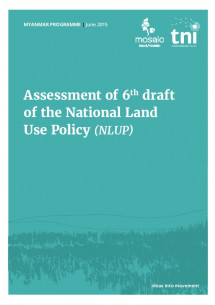Ideas into movement
Boost TNI's work
50 years. Hundreds of social struggles. Countless ideas turned into movement.
Support us as we celebrate our 50th anniversary in 2024.

This assessment is in response to the 6th draft of the NLUP, released in May 2015, following months of public and expert consultations. It outlines some of the key positive and negative points of the new draft.

The new draft NLUP has taken on board many of the concerns and recommendations raised by the public during the consultation process, and includes several key issues that would greatly improve Myanmar’s land governance arrangements. However, some serious concerns remain.
As in our past responses to the earlier (5th) draft of the NLUP, we take as our starting point how the draft fulfills principles and provisions negotiated and agreed upon by the world’s governments – including the Government of Myanmar – and captured guidelines of the UN Committee on World Food Security (UN CFS) known as the Voluntary Guidelines on Responsible Governance of Tenure of Land, Fisheries and Forests (hereafter referred to as the “TGs”). In addition, the assessment that follows is based on the English version of NLUP-6.
Our response to the 6th draft of the NLUP builds on our earlier assessment of the previous draft.
We take this opportunity to briefly remind and reiterate our overall perspective on the NLUP. Overall, for Myanmar’s land policy to succeed, it must seek to:
This is because the current land problem plaguing Myanmar society today is rapidly increasing land polarization, which in turn, is tied to a deeper set of problems related to three main and broadly distinct types of situations affecting rural working households and peoples:
It is these three dimensions of the land problem in Myanmar today that define the type of policy response that is needed, and which the NLUP can and must try to address. The NLUP process presents a strategic opportunity to act on these core recommendations toward achieving a solid social foundation for peace, development and democracy after six decades of war and a resurgence of armed conflict. Overall, while the 6th draft of the NLUP goes some way toward meeting this challenge, it should still go further in order to cover all three of the above-mentioned types of situations. While draft #5 addressed situation #1 (existing land tenure insecurity), and draft #6 now addresses situation #3 (need for land restitution), the current draft remains silent on the present and future problem of land concentration. To address this problem, we call on the government to adopt an across-the-board land size ceiling (not only on land concessions) with land redistri- bution and land restitution, along with recognition of informal and customary land users rights, as the core pillar of the new NLUP.